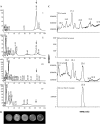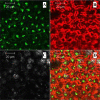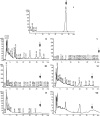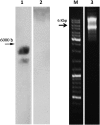Expression of an entire bacterial operon in plants
- PMID: 22353575
- PMCID: PMC3320193
- DOI: 10.1104/pp.111.186197
Expression of an entire bacterial operon in plants
Abstract
Multigene expression is required for metabolic engineering, i.e. coregulated expression of all genes in a metabolic pathway for the production of a desired secondary metabolite. To that end, several transgenic approaches have been attempted with limited success. Better success has been achieved by transforming plastids with operons. IL-60 is a platform of constructs driven from the geminivirus Tomato yellow leaf curl virus. We demonstrate that IL-60 enables nontransgenic expression of an entire bacterial operon in tomato (Solanum lycopersicum) plants without the need for plastid (or any other) transformation. Delivery to the plant is simple, and the rate of expressing plants is close to 100%, eliminating the need for selectable markers. Using this platform, we show the expression of an entire metabolic pathway in plants and delivery of the end product secondary metabolite (pyrrolnitrin). Expression of this unique secondary metabolite resulted in the appearance of a unique plant phenotype disease resistance. Pyrrolnitrin production was already evident 2 d after application of the operon to plants and persisted throughout the plant's life span. Expression of entire metabolic pathways in plants is potentially beneficial for plant improvement, disease resistance, and biotechnological advances, such as commercial production of desired metabolites.
Figures







Similar articles
-
Tomato yellow leaf curl Sardinia virus-resistant tomato plants expressing the multifunctional N-terminal domain of the replication-associated protein show transcriptional changes resembling stress-related responses.Mol Plant Pathol. 2014 Jan;15(1):31-43. doi: 10.1111/mpp.12063. Epub 2013 Aug 4. Mol Plant Pathol. 2014. PMID: 23910556 Free PMC article.
-
Four genes from Pseudomonas fluorescens that encode the biosynthesis of pyrrolnitrin.Appl Environ Microbiol. 1997 Jun;63(6):2147-54. doi: 10.1128/aem.63.6.2147-2154.1997. Appl Environ Microbiol. 1997. PMID: 9172332 Free PMC article.
-
Production of the antifungal compounds phenazine and pyrrolnitrin from Pseudomonas chlororaphis O6 is differentially regulated by glucose.Lett Appl Microbiol. 2011 May;52(5):532-7. doi: 10.1111/j.1472-765X.2011.03036.x. Epub 2011 Mar 21. Lett Appl Microbiol. 2011. PMID: 21362001
-
Physiological and RNA-seq analyses provide insights into the response mechanism of the Cf-10-mediated resistance to Cladosporium fulvum infection in tomato.Plant Mol Biol. 2018 Mar;96(4-5):403-416. doi: 10.1007/s11103-018-0706-0. Epub 2018 Jan 30. Plant Mol Biol. 2018. PMID: 29383477
-
Durability of resistance in tomato and pepper to xanthomonads causing bacterial spot.Annu Rev Phytopathol. 2009;47:265-84. doi: 10.1146/annurev-phyto-080508-081752. Annu Rev Phytopathol. 2009. PMID: 19400644 Review.
Cited by
-
Only minimal regions of tomato yellow leaf curl virus (TYLCV) are required for replication, expression and movement.Arch Virol. 2014 Sep;159(9):2263-74. doi: 10.1007/s00705-014-2066-7. Epub 2014 Apr 10. Arch Virol. 2014. PMID: 24719195 Free PMC article.
-
Advanced genetic tools for plant biotechnology.Nat Rev Genet. 2013 Nov;14(11):781-93. doi: 10.1038/nrg3583. Epub 2013 Oct 9. Nat Rev Genet. 2013. PMID: 24105275 Review.
-
Recent progress in the metabolic engineering of alkaloids in plant systems.Curr Opin Biotechnol. 2013 Apr;24(2):354-65. doi: 10.1016/j.copbio.2012.08.003. Epub 2012 Sep 3. Curr Opin Biotechnol. 2013. PMID: 22954587 Free PMC article. Review.
-
Pyrrolnitrin is integral for antimicrobial activity and phenazine biosynthesis of Pseudomonas chlororaphis strains.World J Microbiol Biotechnol. 2025 May 26;41(6):182. doi: 10.1007/s11274-025-04413-8. World J Microbiol Biotechnol. 2025. PMID: 40415130
-
New biotechnological tools to accelerate scab-resistance trait transfer to apple.Genet Mol Biol. 2017;40(1 suppl 1):305-311. doi: 10.1590/1678-4685-GMB-2016-0043. Epub 2017 Feb 13. Genet Mol Biol. 2017. PMID: 28199444 Free PMC article.
References
-
- Amoutzias G, Van de Peer Y. (2008) Together we stand: genes cluster to coordinate regulation. Dev Cell 14: 640–642 - PubMed
-
- Arima K, Imanaki H, Kousaka M, Fukuta A, Tamura G. (1964) Pyrrolnitrin, a new antibiotic substance, produced by Pseudomonas. Agric Biol Chem 28: 575–576
-
- Baily JA. (1982) Mechanisms of phytoalexine accumulation. In Mansfield, ed, Phytoalexins. Blackie, Glasgow, pp 289–318
-
- Blumenthal T. (2004) Operons in eukaryotes. Brief Funct Genomics Proteomics 3: 199–211 - PubMed
Publication types
MeSH terms
Substances
LinkOut - more resources
Full Text Sources
Other Literature Sources

